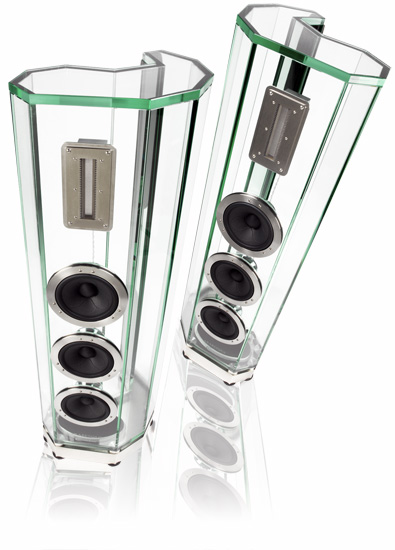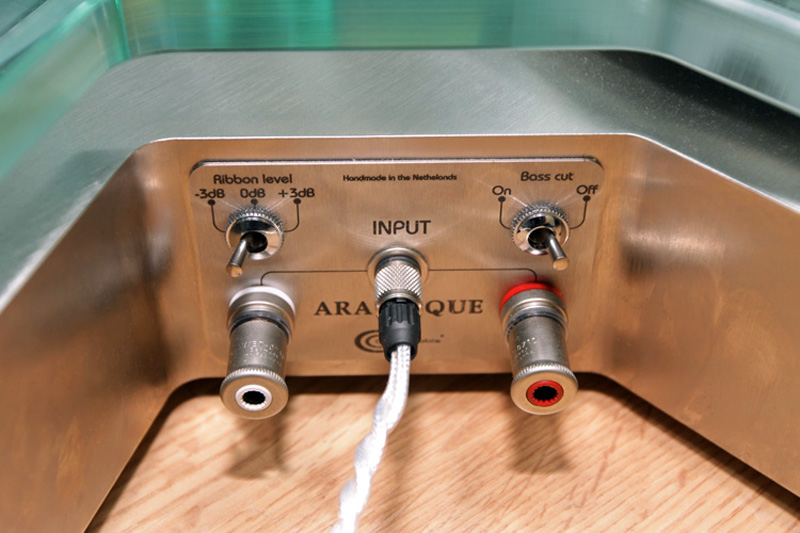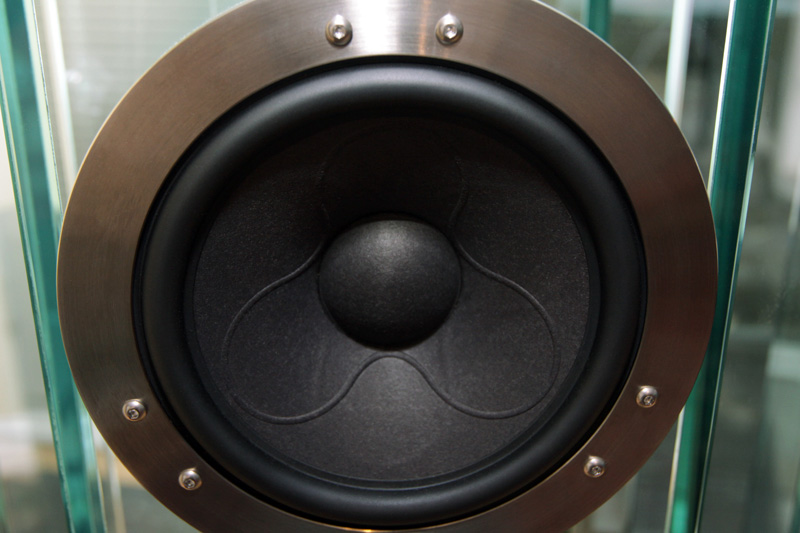| September 1, 2009
Crystal Cable Arabesque Loudspeakers

Category: Pioneering Design
Achievement


|
Take some time to think about how you might answer this
question: Are you an audiophile?
At a recent dinner party, a guest who knew that I write for
Ultra Audio asked me if I was an audiophile. Rather than quickly blurt the
affirmative, I considered the ramifications of such an answer.
In some circles, audiophiles are viewed as narrow-minded,
obsessive, and somewhat antisocial -- think stamp collectors, but not as well adjusted.
It’s easy to see why. I explained to this guest that I was reluctant to accept all
the baggage that came along with the audiophile label, but for the purposes of
moving the discussion forward, I said, in effect, "Yes."
It was my kind of party -- 12 women and two men, including
me. Once the cat was out of the bag and those assembled knew that I was knowledgeable
about sound equipment, the questions began to fly. Had my audience been predominantly
male, the conversation would no doubt have turned to amplifier power, subwoofers, cable
thicknesses, and the like. But with the women outnumbering the men six to one -- and I
know I’m generalizing here -- this group’s questions focused on that most
visible audio component, the loudspeaker, and how to get good sound from a pair of them
without having to plonk down two wooden boxes in the most conspicuous and least convenient
places in the room.
I was stymied. The only components I could think of that
fit my questioners’ requirements were the Mirage Nanosats -- and even those not
because they’re so attractive to look at, but because they’re small and easily
placed.
Most speakers are built for and by men. For the most part
they're blocky, bland, and have all the elegance of a Soviet tank. Sure, you can dress up
that box in a nice veneer and sculpt its shape a bit, but you’re still left with a
rectangle that bears more than a passing resemblance to the container within which it was
shipped. But this lack of real elegance is fine, really, because we're audiophiles, right?
It's the sound that's important, not the aesthetics.
Imagine what a price-no-object, sky’s-the-limit
loudspeaker might look like had the person fully in charge of its design been a woman, if
feminine sensibilities had guided that process, beginning with the mandate that the
speaker must [gasp] be beautiful to look at. Sure, it’s got to sound
spectacular -- that’s a given -- but if it’s not also drop-dead gorgeous, then
as far as this particular chief designer would be concerned, it’s a flop. One
thing’s for sure: the final result wouldn’t be yet another rectangular wooden
box.
This preamble isn't idle banter. I wanted to get you into
the mindset you're going to need in order to properly appreciate the Crystal Cable
Arabesque, the subject of this review. Without some form of attitude adjustment nudging
you away from the audiophile nothing-matters-but-sound viewpoint, well, you just
wouldn't get it.
The Arabesque is a speaker in a class of one. It's a rare
item -- a component that's designed to be an object of art that can stand alone even when
not connected to a stereo system. And it's got a price tag to match, retailing as it does
for $65,000 USD per pair. The new Ultra
Audio gallery contains a number of excellent photos of the Arabesque taken by our
own Doug Schneider; I suggest you take a good long look at them. But photos don’t
tell the whole story. I’ve had a pair of Arabesques in my listening room for several
months now, and each time I walk into the room, I find my breath taken away by their cool,
crisp structural elegance.
Before we go any further, I want to make one point,
and make it clearly: The Arabesques are not novelty speakers. Don't let the
audiophile mindset sway you towards thinking that they're a beautiful enclosure housing
transducers chosen as an afterthought. This speaker was conceived as an assault on
the high end, and much sweat, brain power, and design work went into its creation. The
flip side of the it's-got-to-look-good coin, according to Gabi van der Kley, the president
of Crystal Cable, is that if it doesn't sound superb, it's also a failure. These
are stiff, almost diametrically opposed design goals.
At the beginning of 2009, in his "The
Traveler" article in SoundStage!, Doug Schneider went into great detail
as he recounted the story of the Arabesque’s design and I'd like to direct you
there to read about the speaker’s fascinating genesis. Since Doug's already covered
in great detail most of the technical makeup of this speaker, I'll just provide you with
an overview so that I can get on with what matters most -- how this speaker sounds.
Constructed of strips of 3/4"-thick glass, the
Arabesque presented a daunting reverse-engineering challenge. According to Crystal Cable,
only one company, in Germany, was up to the challenge of cutting the glass with sufficient
precision. The strips are glued together with an adhesive that bonds only in a vacuum.
Looking at the joins from any angle reveals a complete lack of voids between edges. Such
precision gives the speaker an additional helping of visual elegance.
As the Arabesque is completely transparent, the engineers
were unable to factor any internal damping materials into the design -- the overall
elegance would be somewhat diminished by a bunch of Dacron stuffing jammed inside, right?
The Arabesque’s three high-end Scan-Speak Illuminator
6.5" mid-woofers seem to float in mid-air, and from this technophile’s
view, their sculpted baskets and brushed-steel magnet assemblies complement the
cabinet’s austere beauty. The single ribbon tweeter is a solid silver-colored block
that neither enhances or detracts from the speaker’s overall grace, but at least
it’s well finished.
The woofers are connected in parallel: all three are fed
the same signal. This means the Arabesque is a two-way speaker, which was part of the
design right from the start. The woofers are connected via a single internal run of
Crystal Cable Dreamline wire, beautifully dressed and routed for a clean, spare
appearance. The cable disappears into the bottom of the speaker, heading into the base, a
solid block of stainless steel that serves double duty as the home of the speaker’s
crossover, which resides in a hollow machined out of the bottom.
Some mundane facts about this ethereal speaker: Crystal
Cable claims a high efficiency of 95dB and a lowish impedance of 4 ohms, both figures no
doubt the result of those three woofers running in parallel. My 100Wpc tubed amplifier had
no trouble running the Arabesques to outlandishly loud levels. Crystal claims a frequency
response of 27Hz-100kHz, +/-3dB. The Arabesque is weighty, tipping the scales at 220
pounds. Hopefully, the dealer will help with installation, especially considering the
coffin-sized wooden crates the speakers are shipped in. According to Benjamin Scarcelli of
Audio Basics, Crystal’s Canadian distributor, the Arabesques themselves are quite
rugged -- there’s no need to worry about them shattering. Still, I didn't move them
very much just in case . . .
The Arabesque is set up for single wiring with normal
binding posts, and also with Crystal Cable's proprietary screw-on connector for use with
the company's own Dreamline speaker cable, which I used for the duration of this review.
The 9' Dreamline cables retail for -- gulp -- $17,500 the pair. Sharing space near
the speaker connector are two switches: one controls the bass alignment, and the other
boosts or cuts the treble. I left both switches in their neutral positions, which seemed
to work just great for my needs.

The Arabesque's connectors and switches. View the
entire Arabesque gallery here.
System context
I drove the Arabesques exclusively with my Audio Research
VT100 tubed amplifier. I experimented with both my own Analysis Plus Solo Crystal Oval
balanced and sets of Crystal’s Dreamline interconnects between amp and preamp, and
between preamp and phono stage. Some swapping back and forth revealed a clear (ha!)
preference for the Crystal Cable wires.
About halfway through the review period I received my new
Roksan Shiraz cartridge, which I put in place of a Shelter 501 Mk.II cartridge. The
Arabesque speakers instantly showed me how much better the Shiraz is than the Shelter.
Near the end of the review, Gilbert Yeung of Blue Circle Audio delivered his latest phono
stage, the BC703 (review forthcoming). Once again, the Arabesque made no bones about the
superiority of Gilbert’s latest assault on the state of the art over my own Aqvox
Phono 2 CI. This is one heckuva revealing speaker.
My Sonic Frontiers SFL2 preamp still makes me happy, why
get rid of it? Same goes for my Pro-Ject RPM 10 turntable. It’s so pretty.
Power was ably conditioned by my Shunyata Research Hydra
Model-6, and power cables were Shunyata Taipans, though I did experiment with Crystal
Cable’s Dreamline AC cords. I couldn’t conclusively choose a favorite between
these two, so I left the Shunyata cords in place as it means one less thing to do when I
have to return everything to Crystal.
Listening
It took a while to get the Arabesques set up to my
satisfaction. Because those three bass/midrange drivers present a large line array, I
found I needed to get some distance from the speakers before the outputs of its four
drivers fully integrated. My seating options limited me to a maximum of 9.5’ from the
fronts of the speakers. This distance, in my opinion, is just barely enough. Ideally,
I’d liked to have been another 1’ or 2’ farther back. Sitting so close to
the speakers meant I couldn’t quite get as expansive a soundstage in my room as
I’d heard in the much larger room in which Crystal Cable demonstrated the Arabesques
at the Salon Son & Image, in Montreal.
Still, even with this limitation, the Arabesques settled in
wonderfully. I found a heck of a lot to like about these formidable speakers, but from the
first note of every listening session, three qualities consistently jumped to the fore.
First, there was an impressive top-to-bottom coherence.
I’ll go into details shortly, but in brief, the speaker’s top end was delicate
and airy yet juicily substantial, and the midrange meshed wonderfully with it, with a very
slightly forward sound. Add to that a rich, reasonably weighty bottom, and this speaker
immediately grabbed my attention right across the audioband. But don’t read
"immediately grabbed my attention" and "very slightly forward" as code
for "the Arabesque is a forward-sounding speaker." That wasn’t it at all. I
consistently found myself listening to the Arabesques at higher-than-usual volumes, and
that’s not something I can do with an aggressive speaker. The Arabesque was not in
the least aggressive, but immediately grabbed my attention by presenting heaps of detail
in an utterly relaxed manner. Take the domestic pressing of Nirvana’s Unplugged in
New York (LP, DGC 24727), in all its poignant majesty. This album was recorded rather
hot, and any additional crispness would have made me reach for the volume knob. Through
the Arabesques, I could listen to "Lake of Fire" at near-live volumes. When
cranked up, the Arabesques pushed Kurt Cobain’s voice slightly forward of the plane
of the speakers without shoving it down my throat. The rest of the band held realistic
positions without any instrument receiving preferential treatment. In fact, the lateral
spread of instruments and the depth of the soundstage were very good, considering how
close I sat to the speakers.
Another immediately obvious characteristic of the Arabesque
was its way with dynamics. It handled soft to loud transients with a quickness matched
only, in my experience, by large horns. Classic Records tends to just nail their
vinyl reissues, but they really outdid themselves with their 200gm LP of Peter
Gabriel’s third eponymous solo album (Atlantic/Classic PG 3-200G). The Arabesque
presented with almost frightening clarity the myriad little details buried in this dense,
murky, yet profoundly complex album. The creaking floorboards in "Intruder" just
popped out of the soundstage, as did Phil Collins’ rapid-fire drum fills in "No
Self Control." (By the way, what the hell happened to Phil Collins? Did his musical
integrity disappear with his hair? Man, he used to be one heck of a drummer!)
I’m not sure to what I should attribute the
Arabesque’s lightning way with dynamics, but I’d wager it’s got something
to do with those three midrange drivers working in parallel -- they don’t have to
move anywhere near as far as would a single dedicated driver pushing around the same
volume of air. I imagine they can thus react more quickly to the signals they’re fed.
Whatever the reason, the Arabesque was one snappy speaker.
The third quality was the overt silkiness of the
Arabesque’s ribbon tweeter. If I were listening to the Arabesque blind, without
knowing anything about its driver complement, I’m certain I’d guess I was
listening to a ribbon tweeter. There's a combination of almost limitless extension,
quick dynamics, and just plain old sweetness to a good ribbon tweeter, and the one in the
Arabesque is very good indeed. According to Crystal, the Arabesque’s midrange drivers
hand over to the tweeter at a very low 1800Hz, which means that one heck of a lot of
information is coming through that ribbon. But the tweeter never sounded as if it was
operating at an extreme limit. Right from the high notes of Coltrane’s sawtooth sax
to Elvin Jones’ crisp ride cymbal in "Resolution," from A Love Supreme (LP,
Impulse! GR-155), the Arabesque never let on that it was straining -- in fact, quite the
contrary. The Arabesque managed to make that ride cymbal sound silky-smooth while
retaining all the dissonant harmonic overtones so often glossed over by other speakers.
Perhaps my only complaint about the Arabesque is that I
would have welcomed just a bit more bass slam. Not that the Arabesque was bass-shy
-- not by a long shot. When I’m feeling the slightest bit down -- maybe due to girl
troubles, maybe the weather -- I like to slam some Tom Waits on the ’table. My buddy
Tom always makes me feel better. On "Make It Rain," from Real Gone (LP,
Anti- 86678), there’s a serious drop-down note somewhere around 40Hz, and the
Arabesques reproduced it with authority. The note was a little lower in level than
I’m used to, but not outrageously so. The Arabesque’s low end was eminently
satisfying -- rich, well-defined, steel-trap tight -- but didn’t have quite the
impact you’d expect from a $65,000/pair speaker. For this kind of coin, I’d
expect to feel the impact from percussion instruments in my chest.

One of the Arabesque's three Scan-Speak Illuminator
drivers. View the entire Arabesque gallery here.
But consider that slight lack of slam in context. I’m
holding the Arabesque to the standards of a speaker that can only be considered extremely
expensive. However, the Arabesque’s overall coherence, its silky highs and rich,
juicy midrange, made for an absolutely immersive listening experience that needed to make
no apologies for its gorgeous appearance.
Conclusion
While the Crystal Cable Arabesque is by far the most
expensive speaker I've had in my room, it's also the best-sounding speaker I've had in my
room. But the Arabesque is not aimed at the normal audiophile. Those who care about sound
quality first and foremost, with all other considerations falling far, far back,
won’t be willing to spring for the cost of entry. Instead, they’ll look for a
more conventional speaker, probably one that sells for less money. No matter how much I love
its sound, the Arabesque is not meant for me.
But I can imagine a music lover who values great
sound, who has more money than God, watching his wife go gaga over the Arabesques as she
visualizes these two massive Swarovski crystals perched in the middle of her living room
making wonderful music. That audiophile, I imagine, would see the Arabesque as an
absolute bargain.
. . . Jason Thorpe
jasont@ultraaudio.com
Crystal Cable Arabesque Loudspeakers
Price: $65,000 USD per pair.
Warranty: Five years parts and labor.
Crystal Cable BV
Edisonweg 8b
6662 NW Elst
The Netherlands
Phone: +31 481-483-880
Fax: +31 26-353-9048
E-mail: info@crystalcable.com
Website: www.crystalcable.com
Canadian distributor:
Audio Basics Inc.
3800 Steeles Ave. W., Suite 100E
Vaughan, Ontario L6A L4L 4G9
Canada
Phone: (905) 303-9232
Fax: (905) 303-8239
E-mail: contact@audiobasics.com
Website: www.audiobasics.com
|